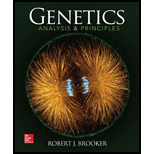
Concept explainers
With regard to pedigree analysis, make a list of observations that distinguish recessive, dominant, and X-linked patterns of inheritance.
To review:
The difference between recessive, X-linked, and dominant patterns of inheritance in accordance with the Pedigree analysis.
Introduction:
Pedigree analysis is the method used to determine the inheritance of genetic disorders. It is an important tool for studying the inherited disorders in the generations. The pedigree chart helps to visualize the relations between the large extended families.
Explanation of Solution
Differentiation between X-linked, dominant, and recessivepatterns of inheritance, according to the pedigree analysis are shown below:
| Recessive inheritance | X-linked inheritance | Dominant inheritance |
| Affected offspring has unaffected parents. | Both, parents and offspring are affected. | Unaffected offspring have affected parents. |
| It is associated with autosomal genes. | Based on the X-chromosome genes. | It associated with the gene on the autosome. |
| Recessive traits affect females and males equally. | Traits skip generations to appear and males are more affected than females. Females are the main carriers of the disease. | Dominant traits affect both male and female offspring in each generation. Dominant X-linked is always passed on from father to daughter. |
Therefore, it can be concluded thatX linked disease affects males, while in dominant inheritance, the disease affects the daughter. In recessive inheritance, both, the males and females have an equal chance of disease inheritance.
Want to see more full solutions like this?
Chapter 24 Solutions
Genetics: Analysis and Principles
- Not part of a graded assignment, from a past midtermarrow_forwardNoggin mutation: The mouse, one of the phenotypic consequences of Noggin mutationis mispatterning of the spinal cord, in the posterior region of the mouse embryo, suchthat in the hindlimb region the more ventral fates are lost, and the dorsal Pax3 domain isexpanded. (this experiment is not in the lectures).a. Hypothesis for why: What would be your hypothesis for why the ventral fatesare lost and dorsal fates expanded? Include in your answer the words notochord,BMP, SHH and either (or both of) surface ectoderm or lateral plate mesodermarrow_forwardNot part of a graded assignment, from a past midtermarrow_forward
- Explain in a flowcharts organazing the words down below: genetics Chromosomes Inheritance DNA & Genes Mutations Proteinsarrow_forwardplease helparrow_forwardWhat does the heavy dark line along collecting duct tell us about water reabsorption in this individual at this time? What does the heavy dark line along collecting duct tell us about ADH secretion in this individual at this time?arrow_forward
 Human Heredity: Principles and Issues (MindTap Co...BiologyISBN:9781305251052Author:Michael CummingsPublisher:Cengage Learning
Human Heredity: Principles and Issues (MindTap Co...BiologyISBN:9781305251052Author:Michael CummingsPublisher:Cengage Learning Human Biology (MindTap Course List)BiologyISBN:9781305112100Author:Cecie Starr, Beverly McMillanPublisher:Cengage Learning
Human Biology (MindTap Course List)BiologyISBN:9781305112100Author:Cecie Starr, Beverly McMillanPublisher:Cengage Learning
 Biology (MindTap Course List)BiologyISBN:9781337392938Author:Eldra Solomon, Charles Martin, Diana W. Martin, Linda R. BergPublisher:Cengage Learning
Biology (MindTap Course List)BiologyISBN:9781337392938Author:Eldra Solomon, Charles Martin, Diana W. Martin, Linda R. BergPublisher:Cengage Learning Biology: The Dynamic Science (MindTap Course List)BiologyISBN:9781305389892Author:Peter J. Russell, Paul E. Hertz, Beverly McMillanPublisher:Cengage Learning
Biology: The Dynamic Science (MindTap Course List)BiologyISBN:9781305389892Author:Peter J. Russell, Paul E. Hertz, Beverly McMillanPublisher:Cengage Learning Biology Today and Tomorrow without Physiology (Mi...BiologyISBN:9781305117396Author:Cecie Starr, Christine Evers, Lisa StarrPublisher:Cengage Learning
Biology Today and Tomorrow without Physiology (Mi...BiologyISBN:9781305117396Author:Cecie Starr, Christine Evers, Lisa StarrPublisher:Cengage Learning





